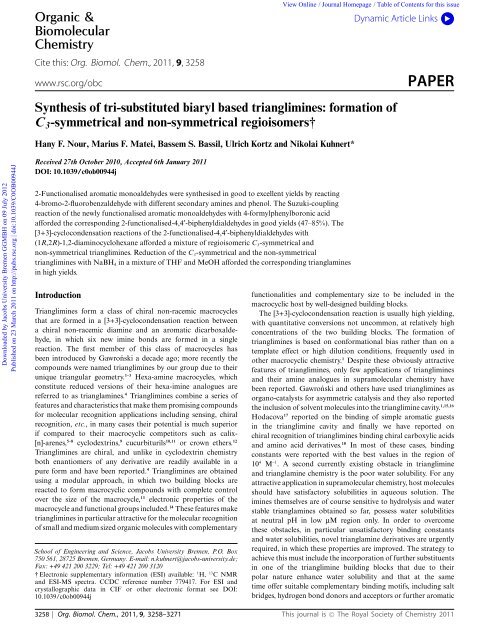The Development of Novel Antibiotics Using ... - Jacobs University
The Development of Novel Antibiotics Using ... - Jacobs University
The Development of Novel Antibiotics Using ... - Jacobs University
Create successful ePaper yourself
Turn your PDF publications into a flip-book with our unique Google optimized e-Paper software.
Organic &<br />
Biomolecular<br />
Chemistry<br />
Cite this: Org. Biomol. Chem., 2011, 9, 3258<br />
www.rsc.org/obc<br />
Dynamic Article Links<br />
Synthesis <strong>of</strong> tri-substituted biaryl based trianglimines: formation <strong>of</strong><br />
C 3 -symmetrical and non-symmetrical regioisomers†<br />
Hany F. Nour, Marius F. Matei, Bassem S. Bassil, Ulrich Kortz and Nikolai Kuhnert*<br />
View Online / Journal Homepage / Table <strong>of</strong> Contents for this issue<br />
PAPER<br />
Downloaded by <strong>Jacobs</strong> <strong>University</strong> Bremen GGMBH on 09 July 2012<br />
Published on 23 March 2011 on http://pubs.rsc.org | doi:10.1039/C0OB00944J<br />
Received 27th October 2010, Accepted 6th January 2011<br />
DOI: 10.1039/c0ob00944j<br />
2-Functionalised aromatic monoaldehydes were synthesised in good to excellent yields by reacting<br />
4-bromo-2-fluorobenzaldehyde with different secondary amines and phenol. <strong>The</strong> Suzuki-coupling<br />
reaction <strong>of</strong> the newly functionalised aromatic monoaldehydes with 4-formylphenylboronic acid<br />
afforded the corresponding 2-functionalised-4,4¢-biphenyldialdehydes in good yields (47–85%). <strong>The</strong><br />
[3+3]-cyclocondensation reactions <strong>of</strong> the 2-functionalised-4,4¢-biphenyldialdehydes with<br />
(1R,2R)-1,2-diaminocyclohexane afforded a mixture <strong>of</strong> regioisomeric C 3 -symmetrical and<br />
non-symmetrical trianglimines. Reduction <strong>of</strong> the C 3 -symmetrical and the non-symmetrical<br />
trianglimines with NaBH 4 in a mixture <strong>of</strong> THF and MeOH afforded the corresponding trianglamines<br />
in high yields.<br />
Introduction<br />
Trianglimines form a class <strong>of</strong> chiral non-racemic macrocycles<br />
that are formed in a [3+3]-cyclocondensation reaction between<br />
a chiral non-racemic diamine and an aromatic dicarboxaldehyde,<br />
in which six new imine bonds are formed in a single<br />
reaction. <strong>The</strong> first member <strong>of</strong> this class <strong>of</strong> macrocycles has<br />
been introduced by Gawroński a decade ago; more recently the<br />
compounds were named trianglimines by our group due to their<br />
unique triangular geometry. 1–3 Hexa-amine macrocycles, which<br />
constitute reduced versions <strong>of</strong> their hexa-imine analogues are<br />
referred to as trianglamines. 4 Trianglimines combine a series <strong>of</strong><br />
features and characteristics that make them promising compounds<br />
for molecular recognition applications including sensing, chiral<br />
recognition, etc., in many cases their potential is much superior<br />
if compared to their macrocyclic competitors such as calix-<br />
[n]-arenes, 5–8 cyclodextrins, 9 cucurbiturils 10,11 or crown ethers. 12<br />
Trianglimines are chiral, and unlike in cyclodextrin chemistry<br />
both enantiomers <strong>of</strong> any derivative are readily available in a<br />
pure form and have been reported. 4 Trianglimines are obtained<br />
using a modular approach, in which two building blocks are<br />
reacted to form macrocyclic compounds with complete control<br />
over the size <strong>of</strong> the macrocycle, 13 electronic properties <strong>of</strong> the<br />
macrocycle and functional groups included. 14 <strong>The</strong>se features make<br />
trianglimines in particular attractive for the molecular recognition<br />
<strong>of</strong> small and medium sized organic molecules with complementary<br />
School <strong>of</strong> Engineering and Science, <strong>Jacobs</strong> <strong>University</strong> Bremen, P.O. Box<br />
750 561, 28725 Bremen, Germany. E-mail: n.kuhnert@jacobs-university.de;<br />
Fax: +49 421 200 3229; Tel: +49 421 200 3120<br />
† Electronic supplementary information (ESI) available: 1 H, 13 CNMR<br />
and ESI-MS spectra. CCDC reference number 779417. For ESI and<br />
crystallographic data in CIF or other electronic format see DOI:<br />
10.1039/c0ob00944j<br />
functionalities and complementary size to be included in the<br />
macrocyclic host by well-designed building blocks.<br />
<strong>The</strong> [3+3]-cyclocondensation reaction is usually high yielding,<br />
with quantitative conversions not uncommon, at relatively high<br />
concentrations <strong>of</strong> the two building blocks. <strong>The</strong> formation <strong>of</strong><br />
trianglimines is based on conformational bias rather than on a<br />
template effect or high dilution conditions, frequently used in<br />
other macrocyclic chemistry. 1 Despite these obviously attractive<br />
features <strong>of</strong> trianglimines, only few applications <strong>of</strong> trianglimines<br />
and their amine analogues in supramolecular chemistry have<br />
been reported. Gawroński and others have used trianglimines as<br />
organo-catalysts for asymmetric catalysis and they also reported<br />
the inclusion <strong>of</strong> solvent molecules into the trianglimine cavity. 1,15,16<br />
Hodacova 17 reported on the binding <strong>of</strong> simple aromatic guests<br />
in the trianglimine cavity and finally we have reported on<br />
chiral recognition <strong>of</strong> trianglimines binding chiral carboxylic acids<br />
and amino acid derivatives. 18 In most <strong>of</strong> these cases, binding<br />
constants were reported with the best values in the region <strong>of</strong><br />
10 4 M -1 . A second currently existing obstacle in trianglimine<br />
and trianglamine chemistry is the poor water solubility. For any<br />
attractive application in supramolecular chemistry, host molecules<br />
should have satisfactory solubilities in aqueous solution. <strong>The</strong><br />
imines themselves are <strong>of</strong> course sensitive to hydrolysis and water<br />
stable trianglamines obtained so far, possess water solubilities<br />
at neutral pH in low mM region only. In order to overcome<br />
these obstacles, in particular unsatisfactory binding constants<br />
and water solubilities, novel trianglamine derivatives are urgently<br />
required, in which these properties are improved. <strong>The</strong> strategy to<br />
achieve this must include the incorporation <strong>of</strong> further substituents<br />
in one <strong>of</strong> the trianglimine building blocks that due to their<br />
polar nature enhance water solubility and that at the same<br />
time <strong>of</strong>fer suitable complementary binding motifs, including salt<br />
bridges, hydrogen bond donors and acceptors or further aromatic<br />
3258 | Org. Biomol. Chem., 2011, 9, 3258–3271 This journal is © <strong>The</strong> Royal Society <strong>of</strong> Chemistry 2011

















